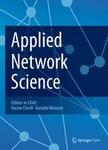版权所有:内蒙古大学图书馆 技术提供:维普资讯• 智图
内蒙古自治区呼和浩特市赛罕区大学西街235号 邮编: 010021

作者机构:New York Univ Abu Dhabi POB 129188 Abu Dhabi U Arab Emirates Ronin Inst Montclair NJ 07043 USA NYU Tandon Sch Engn Brooklyn NY 11201 USA
出 版 物:《APPLIED NETWORK SCIENCE》 (Appl. Netw. Sci.)
年 卷 期:2021年第6卷第1期
页 面:1-30页
核心收录:
基 金:NYUAD Center for Interacting Urban Networks (CITIES) - Tamkeen under the NYUAD Research Institute Award [CG001] Swiss Re Institute under the Quantum CitiesTM initiative
主 题:Urban street networks Self-organization Scale-freeness Metropolis algorithm MaxEnt Symmetries Conserved quantities Self-similarity Surprisal Graph matchings Ising model Watts– Strogatz model Small-world crossover
摘 要:Urban street networks of unplanned or self-organized cities typically exhibit astonishing scale-free patterns. This scale-freeness can be shown, within the maximum entropy formalism (MaxEnt), as the manifestation of a fluctuating system that preserves on average some amount of information. Monte Carlo methods that can further this perspective are cruelly missing. Here we adapt to self-organized urban street networks the Metropolis algorithm. The coming to equilibrium distribution is established with MaxEnt by taking scale-freeness as prior hypothesis along with symmetry-conservation arguments. The equilibrium parameter is the scaling;its concomitant extensive quantity is, assuming our lack of knowledge, an amount of information. To design an ergodic dynamics, we disentangle the state-of-the-art street generating paradigms based on non-overlapping walks into layout-at-junction dynamics. Our adaptation reminisces the single-spin-flip Metropolis algorithm for Ising models. We thus expect Metropolis simulations to reveal that self-organized urban street networks, besides sustaining scale-freeness over a wide range of scalings, undergo a crossover as scaling varies-literature argues for a small-world crossover. Simulations for Central London are consistent against the state-of-the-art outputs over a realistic range of scaling exponents. Our illustrative Watts-Strogatz phase diagram with scaling as rewiring parameter demonstrates a small-world crossover curving within the realistic window 2-3;it also shows that the state-of-the-art outputs underlie relatively large worlds. Our Metropolis adaptation to self-organized urban street networks thusly appears as a scaling variant of the Watts-Strogatz model. Such insights may ultimately allow the urban profession to anticipate self-organization or unplanned evolution of urban street networks.